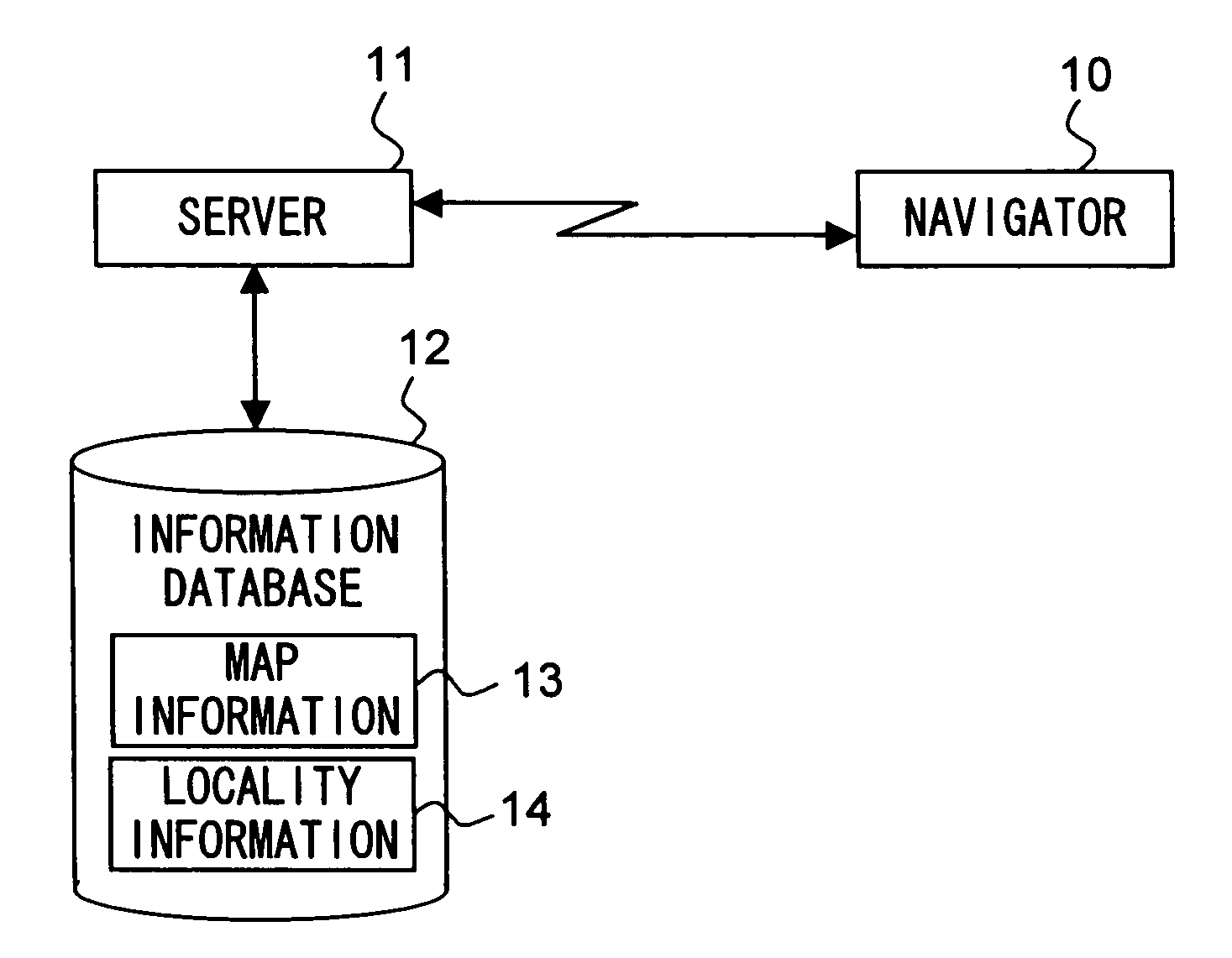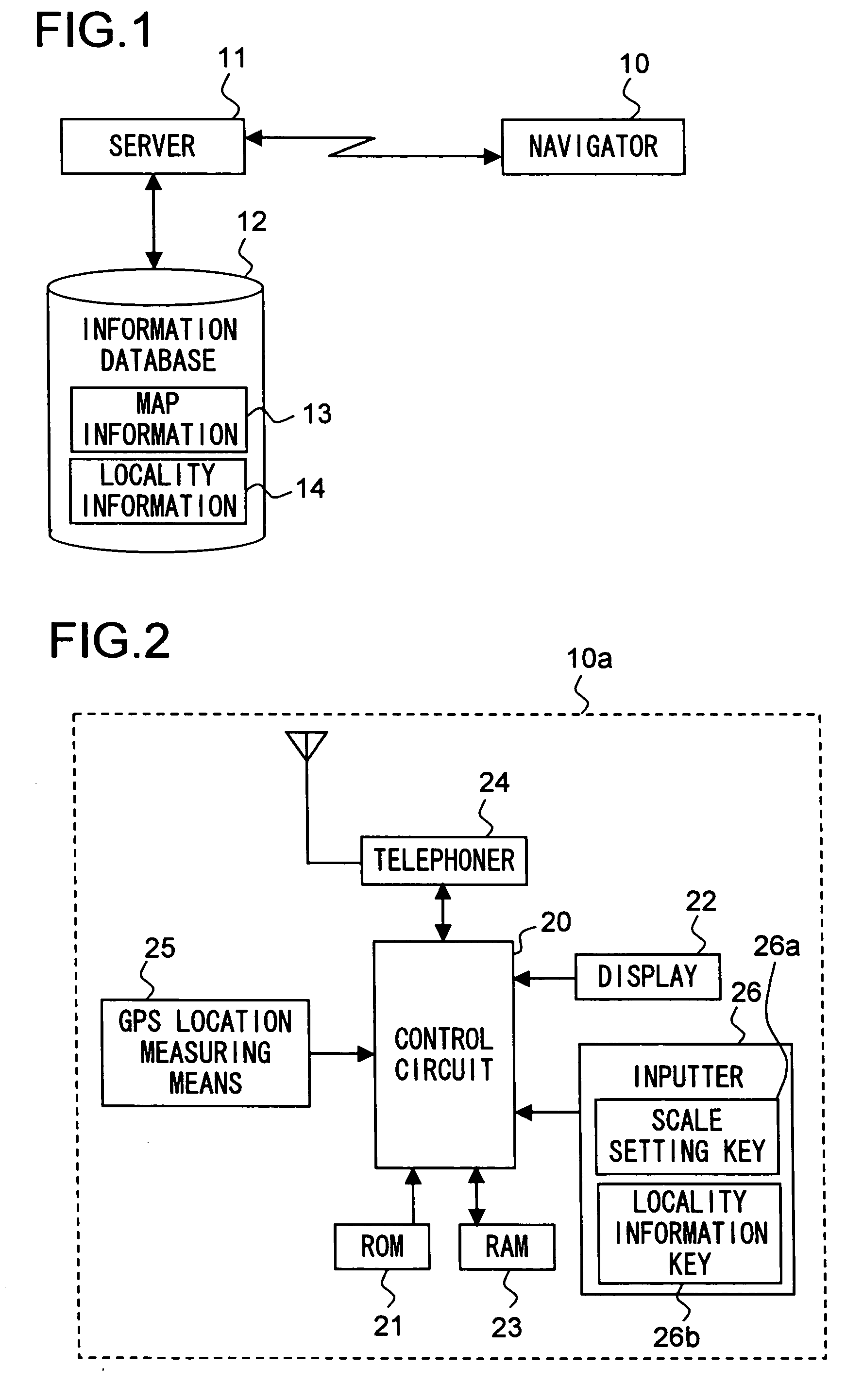Navigator
- Summary
- Abstract
- Description
- Claims
- Application Information
AI Technical Summary
Benefits of technology
Problems solved by technology
Method used
Image
Examples
first embodiment
[0055]FIG. 1 is a diagram showing the configuration of a communications system employing a navigator according to the present invention. When the navigator 10 requests map information 13 or locality information 14 from a server 11, the server 11 reads out appropriate map information 13 or locality information 14 from an information database 12 according to the conditions requested by the navigator 10, and then delivers the retrieved information to the navigator 10. Here, the map information 13 is composed of a plurality of sets of map information on different scales, and the locality information 14 is so composed as to correspond to the map information 13 on those different scales.
[0056]The navigator 10 and the server 11 may communicate with each other by any means of communication so long as they can communicate with each other. For example, in a case where information is delivered over the Internet, it is possible to use a telephone network such as a mobile or cellular telephone n...
embodiment 1
[0069]Example 1 deals with a case where the navigator 10a is used with no destination set. FIG. 4 is a flow chart showing the operation of the navigator 10a. First, in step S40, map information or locality information on such a scale as to show the type of road passing at the current location is received and stored in the RAM 23, and then the map information or locality information is read out from the RAM 23 and displayed on the display 22 with the current location superimposed thereon. Suppose now that the current location is on a town street. Then, the control circuit 20 selects, for example, the scale of 100 m from the scale table 30 shown in FIG. 3, then receives map information or locality information on that scale, and then displays an image 50 as shown in FIG. 5. In the figure, the arrow indicates the current location.
[0070]The flow then proceeds from step S40 to step S41, where whether or not the type of road passing at the current location matches the scale of the map bein...
example 2
[0073]Example 2 deals with a navigator 10a that is just like that of Example 1 but that additionally increases the scale of the displayed map whenever a branch point is approached. FIG. 7 is a flow chart showing the operation of the navigator 10a. First, in step S70, as in step S40 in Example 1, map information or locality information is displayed. Suppose now that the current location is on a national road. The, the control circuit 20 selects, for example, the scale of 2 km from the scale table 30 shown in FIG. 3, then receives map information or locality information on that scale, and then displays an image 80 as shown in FIG. 8.
[0074]The flow then proceeds from step S70 to S71, where whether or not there is a branch point within a predetermined area (for example, within 2 km) ahead of the current location is checked. If, in step S71, there is no branch point within the predetermined area ahead, then the flow proceeds to step 25, where, as in step S41 in Example 1, whether or not ...
PUM
 Login to View More
Login to View More Abstract
Description
Claims
Application Information
 Login to View More
Login to View More - R&D
- Intellectual Property
- Life Sciences
- Materials
- Tech Scout
- Unparalleled Data Quality
- Higher Quality Content
- 60% Fewer Hallucinations
Browse by: Latest US Patents, China's latest patents, Technical Efficacy Thesaurus, Application Domain, Technology Topic, Popular Technical Reports.
© 2025 PatSnap. All rights reserved.Legal|Privacy policy|Modern Slavery Act Transparency Statement|Sitemap|About US| Contact US: help@patsnap.com



